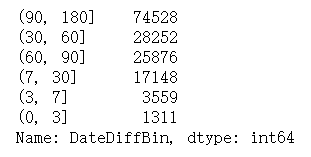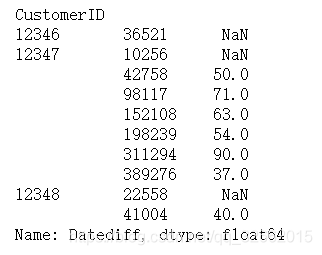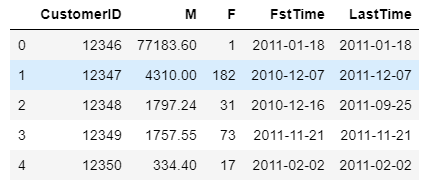英国电商用户行为分析
一.数据的获取
数据集:https://archive.ics.uci.edu/ml/datasets/online+retail#
数据集简介:英国零售在2010.12.1至2011.12.9发生的交易订单
内容:
InvoiceNo:发票编号。为每笔订单唯一分配的6位整数。若以字母’C’开头,则表示该订单被取消。
StockCode:产品代码。为每个产品唯一分配的编码。
Description:产品描述。
Quantity:数量。每笔订单中各产品分别的数量。
InvoiceDate:发票日期和时间。每笔订单发生的日期和时间。
UnitPrice:单价。单位产品价格,单位为英镑。
CustomerID:客户编号。为每个客户唯一分配的5位整数。
Country:国家。客户所在国家/地区的名称。
二.读取数据
加载需要用到的库
import numpy as np
import pandas as pd
import matplotlib.pyplot as plt
import seaborn as sns
df_sale =pd.read_excel(r'E:/学习资料/数据分析练习/Online Retail/Online Retail.xlsx')
df_sale.info()
df_sale.describe()
三.清洗数据
3.1 删除重复值,观察空值
before = df_sale.shape[0]
df_sale.drop_duplicates(inplace=True)
after = df_sale.shape[0]
print("delete %d duplicated raws"%(before-after))
df_sale.isnull().sum().sort_values(ascending=False)
删除5268行数据,CustomerID 和Description 存在空值
Description 不影响后面的,空值不做处理。同时发现CustomerID为float,做转换int,将空值填充为0,同时将InvoiceNo转换为字符便于‘C’订单的处理
df_sale['CustomerID']=df_sale['CustomerID'].astype('int')
df_sale['InvoiceNo']=df_sale['InvoiceNo'].astype('str')
df_sale.CustomerID.fillna(value=0,inplace=True)
3.2 异常值的处理
df_sale[(df_sale.Quantity<=0)|(df_sale['UnitPrice']<=0)].head()

观察发票号包含C,想到需要将取消的订单与成功的订单分开,应用到正则表达式
query_c= df_sale.InvoiceNo.str.contains("C")
df_cancel =df_sale.loc[query_c,:].copy()
df_sucess =df_sale.loc[-query_c,:].copy()
在成功的订单的中,还要去掉UnitPrice<0的订单,同时考虑到UnitPrice=0可能为活动,也将其去除
query_free =(df_sucess['UnitPrice']==0)
df_sucess= df_sucess.loc[-query_free,:]
query_minus=(df_sucess['UnitPrice']<0)
df_sucess =df_sucess.loc[-query_minus,:]
同时增加总价这列,检查最终的df_sucess数据
df_sucess['SumPrice']=df_sucess.loc[:,'Quantity']* df_sucess.loc[:,'UnitPrice']
df_sucess.info()
df_sucess.describe()
四.数据分析与可视化(不同维度)
4.1 订单维度:笔单价,连带率
groupInvoiceNo=df_sucess.groupby(r'InvoiceNo')[r'Quantity',r'SumPrice'].agg('sum')
groupInvoiceNo.describe()

笔单价约为533.17英镑,连带率 279件
订单金额与商品件数关系如何?
fig =plt.figure(figsize=(14,4))
sns.distplot(groupInvoiceNo.SumPrice,bins=100,color='c')
plt.title(r'SumPrice distribution of orders')
plt.xticks(np.arange(0,170000,10000))
plt.ylabel(r'Frequency')
plt.grid()
plt.show()
fig =plt.figure(figsize=(14,4))
ax= fig.add_subplot(1,1,1)
sns.distplot(groupInvoiceNo.loc[groupInvoiceNo.SumPrice<2000,'SumPrice'],bins=100,color='c',norm_hist=True)
plt.title(r'SumPrice distribution of orders(below 2000)')
plt.ylabel(r'Frequency')
plt.xticks(np.arange(0,2000,100))
plt.grid()
plt.show()

订单金额集中在500英镑内,三个峰值分别为20英镑内、100-120英镑、300-320英镑。其中300-320英镑的订单数量特别多
观察订单商品数量和总价的关系
fig =plt.figure(figsize=(8,8))
plt.subplot(2,1,1)
plt.scatter(x=groupInvoiceNo.Quantity,y=groupInvoiceNo.SumPrice)
plt.xlabel(r'Quantity ')
plt.ylabel(r'SumPrice')
plt.title(r'Quantity & SumPrice')
plt.subplot(2,1,2)
plt.subplots_adjust(hspace=0.5)
plt.scatter(x=groupInvoiceNo.loc[groupInvoiceNo.Quantity<20000,'Quantity'],y=groupInvoiceNo.loc[groupInvoiceNo.Quantity<20000,'SumPrice'])
plt.xlabel(r'Quantity ')
plt.ylabel(r'SumPrice')
plt.title(r'Quantity & SumPrice(Quantity<20000)')
plt.show()

总体来说订单金额和订单中的商品件数为正相关,但是也存在数量极少,总价极高的订单。
4.2客户维度(客单价,客户的消费金额)
df_customer =df_sucess[df_sucess.CustomerID !=0].copy()
group_customer= df_customer.groupby('CustomerID').agg({'Quantity':['sum'],'SumPrice':['sum'],
'InvoiceNo':lambda x:x.nunique()})
group_customer.columns=['Quantity','SumPrice','InvoiceNo']
group_customer.describe()

人均购买笔数为4笔,中位数为2笔,25%以上的客户仅下过一次单,并未留存。 每位客户平均购买了1187件商品,甚至超过了Q3分位数,最多的客户购买了196915件;客单价为2049英镑, 平均值同样超过了Q3分位数,说明客户的购买力存在较大差距,存在小部分的高消费用户拉高了人均数值
客户订单总金额的分布
fig =plt.figure(figsize=(7,5))
group_customer.SumPrice.plot.hist(bins=100)
plt.title(r"SumPrice Distribution of Customers")
plt.xlabel(r'SumPrice')
plt.ylabel(r'Frequency')
plt.grid()
plt.show()
fig =plt.figure(figsize=(7,5))
group_customer.loc[group_customer.SumPrice<5000,'SumPrice'].plot.hist(bins=50)
plt.title(r"SumPrice Distribution of Customers(SumPrice<5000)")
plt.xlabel(r'SumPrice')
plt.ylabel(r'Frequency')
plt.xticks(range(0,5000,500))
plt.grid()
plt.show()


与前面订单金额的多峰分布相比,客户消费金额的分布呈现单峰长尾形态,金额更为集中,峰值在100-200英镑间
4.3 商品维度(价格,卖的好,对销售额的贡献)
group_goods =df_sucess.groupby('StockCode').agg({'Quantity':sum,'SumPrice':sum})
group_goods['Average']=group_goods.SumPrice/group_goods.Quantity
所有商品的均价:
fig =plt.figure(figsize=(7,5))
group_goods.Average.hist(bins=100)
plt.xlabel(r'Average Price')
plt.title(r'AvgPrice Distribution')
plt.show()
fig =plt.figure(figsize=(7,5))
group_goods.loc[group_goods.Average<40,'Average'].hist(bins=50)
plt.xlabel(r'Average Price')
plt.title(r'AvgPrice Distribution(Average<40)')
plt.show()


峰值是1-2英磅,单价10磅上的商品已经很少见,该电商的定位主要是价格低区间
fig =plt.figure(figsize=(12,4))
plt.subplot(1,2,1)
plt.scatter(x=group_goods.Average,y=group_goods.Quantity)
plt.title(r'AvgPrice & Quantity')
plt.ylabel(r'Quantity')
plt.xlabel(r'Average Price')
plt.grid()
plt.subplot(1,2,2)
plt.subplots_adjust(wspace=0.5)
plt.scatter(x=group_goods.loc[group_goods.Average<80,'Average'],y=group_goods.loc[group_goods.Average<80,'Quantity'])
plt.title(r'AvgPrice & Quantity(Average<80)')
plt.ylabel(r'Quantity')
plt.xlabel(r'Average Price')
plt.grid()
plt.show()
fig =plt.figure(figsize=(12,5))
plt.subplot(1,2,1)
plt.scatter(x=group_goods.Average,y=group_goods.SumPrice)
plt.title(r'AvgPrice & SumPrice')
plt.ylabel(r'SumPrice')
plt.xlabel(r'Average Price')
plt.subplot(1,2,2)
plt.subplots_adjust(wspace=0.5)
plt.scatter(x=group_goods.loc[group_goods.Average<80,'Average'],y=group_goods.loc[group_goods.Average<80,'SumPrice'])
plt.title(r'AvgPrice & SumPrice(Average<80)')
plt.ylabel(r'SumPrice')
plt.xlabel(r'Average Price')
plt.show()

低价区的商品构成了销售额的主要部分,高价的商品虽然单价高昂,并没有带来太多的销售额
4.4 时间维度
对日期进行处理
df_sucess['Month']=df_sucess.InvoiceDate.dt.month
df_sucess['Date']=df_sucess.InvoiceDate.dt.date
按照月份观察销量和总价
group_month=df_sucess.groupby('Month').agg({'InvoiceNo':lambda x:x.nunique(),'SumPrice':sum,'Quantity':sum})
month =group_month.plot(secondary_y ='InvoiceNo', x_compat=True,figsize=(10,5))
month.set_ylabel('Quantity & SumPrice')
month.right_ax.set_ylabel('Order quantities')
month.set_xticks(np.arange(0,12,1))
plt.grid()
plt.show()

除了2011年2月和4月略低外,2010年12月至2011年8月基本维持相近的销售情况;随后在9月-11月连续增长,达到高峰。考虑该电商平台主营礼品,受节日影响可能较大,欧洲重视的万圣节(11月1日)和圣诞节(12月25日)都在年末,与图中的趋势能够相呼应
group_date =df_sucess.groupby(df_sucess.Date).agg({'InvoiceNo':lambda x: x.nunique(),'SumPrice':sum,'Quantity':sum})
group_date.loc[:,['SumPrice','Quantity']].plot(figsize=(10,5))
plt.title('SumPrice & Quantity & Date')
plt.ylabel(r'SumPrice & Quantity ')
group_date.loc[:,['InvoiceNo']].plot(figsize=(10,5))
plt.ylabel(r'InvoiceNo')
plt.title(r'InvoiceNo & Date')
plt.show()


可见销量Quantity和销售额SumPrice的趋势是极趋同的,这也和前一节中分析出该电商以低价商品为主相吻合,商品单价低且价位集中,则销售额主要随销量变化而涨跌,注意到在最后一天(即2011年12月9日),销量、销售额显著激增
将12月的销售额和销量单独拉出来看
df_sucess.Date =pd.to_datetime(df_sucess.Date,format='%Y-%m-%d')
group_daypart=df_sucess.groupby('Date').agg({'InvoiceNo':lambda x:x.nunique(),'SumPrice':sum,'Quantity':sum})
day_part=group_daypart['2011-12-01':].plot(secondary_y = 'InvoiceNo', figsize = (12,6),legend='best')
day_part.set_ylabel('Quantity & SumPrice')
day_part.right_ax.set_ylabel('Order quantities')
plt.show()

2011年12月的前8天基本延续了11月下旬的销售趋势,但在12月9日订单量大幅下降时,却创造了样本区间内销量和销售额的历史新高。说明存在某笔或某几笔购买量极大的订单,从而使得销售额大幅上升
df_sucess[df_sucess.Date=='2011-12-09'].sort_values(by='SumPrice',ascending =False)[:5]

一个英国的客户,一口气购买了8万余件的纸工艺品,贡献了168469英镑的销售额
4.5 国家维度
group_country =df_sucess.groupby('Country').agg({'InvoiceNo':lambda x:x.nunique(),'SumPrice':sum })
group_country.sort_values(by='SumPrice',ascending =False)

可知绝大部分客户仍来自英国本土,主要境外收入来源也多为英国周边国家,这种现象可能和运输成本及语言等有关,也可能是影响力随距离而衰减,可以尝试增加境外的宣传投放,提高知名度;
4.6 客户行为(生命周期,留存,购买周期)
需要先去除没有CustomerID的用户
df_cust_action =df_sucess[df_sucess.CustomerID !=0].copy()
生命周期,第一次购买和最近购买相减
group_life_cycle=df_cust_action.groupby('CustomerID')['Date'].agg([min,max])
group_life_cycle.columns=['Fst','Last']
group_life_cycle['Lifecycle']=(group_life_cycle['Last']-group_life_cycle['Fst']).dt.days
图表展示:
fig=plt.figure(figsize =(8,5))
plt.hist(x=group_life_cycle.Lifecycle,bins=30)
plt.title('Life Cycle Distribution')
plt.ylabel('Customer number')
plt.xlabel('Life Cycle (days)')
plt.grid()
plt.show()

许多用户只消费了一次,没有留存下来,需要更加重视客户初次购买的体验感,对于购买中流程不满意之处,针对加以改进,对新用户采取吸引其购买的手段。将生命周期为0的去除掉再观察
fig=plt.figure(figsize =(8,5))
plt.hist(group_life_cycle.loc[group_life_cycle.Lifecycle>0,'Lifecycle'],bins=30)
plt.title('Life Cycle Distribution(days>0)')
plt.ylabel('Customer number')
plt.xlabel('Life Cycle (days)')
plt.grid()
plt.show()

生命周期在0-70天的客户数略高于50-150天,可以考虑加强前70天内对客户的引导 在150天-330天,属于较高质量客户的生命周期 而在330天以后,则是数量可观的死忠客户,拥有极高的用户粘性
留存率
group_life_cycle=group_life_cycle.reset_index()
customer_retention =df_cust_action.merge(group_life_cycle,on='CustomerID',how='left')
group_customer_retent=customer_retention.loc[:,['CustomerID','Date','Fst','SumPrice']]
group_customer_retent['Datediff']=(group_customer_retent.Date-group_customer_retent.Fst).dt.days
将所有的间隔时间列出来, 留存区间分别取(0,3],(3,7], (7,30] , (30,60], (60,90], (90,180]
day_bins = [0,3,7,30,60,90,180]
group_customer_retent['DateDiffBin'] = pd.cut(group_customer_retent.Datediff,bins = day_bins)
group_customer_retent['DateDiffBin'].value_counts()
customer_rent=pd.pivot_table(group_customer_retent,index='CustomerID',columns ='DateDiffBin',values=['SumPrice'],aggfunc='sum')
customer_rent.shape
![]()
customer_rent=customer_rent.applymap(lambda x:1 if x>0 else 0)
(customer_rent.sum()/customer_rent.shape[0]).plot.bar()
plt.grid()
plt.show()
(customer_rent.sum()/customer_rent.shape[0])

只有3.2%在第一次消费的次日至3天内有过消费,6.6%的客户在4-7天有过消费。分别有40.5%和37.4%的客户在首次消费后的第二个月内和第三个月内有过购买行为。将时间范围继续放宽,有高达67%的客户在90天至半年内消费过。说明该电商网站的客户群体,其采购并非高频行为,但留存下来的老客户忠诚度却极高。结合前文,仅有首次购买行为的客户占总客户的37.5%,如能提高这部分群体的留存率,将会带来很高的收益
购买周期
group_customer_retent.head()
buy_cycle =group_customer_retent.drop('DateDiffBin',axis=1)
def diff(group):
d= group.Datediff-group.Datediff.shift(1)
return d
buy_cycle.drop_duplicates(subset=['CustomerID','Date'],keep='first',inplace=True)
buy_cycle.sort_values(by='Date',ascending=True)
uy_cycle=buy_cycle.groupby('CustomerID').apply(diff)
buy_cycle.head(10)
buy_cycle.hist(bins=70,figsize=(12,6))
plt.xlabel(r'days')
plt.ylabel(r'frequency')
plt.show()

一个右偏分布,峰值在20-70天,说明大部分留存客户的购买周期集中于此,建议可以每隔30天左右对客户进行些优惠活动的信息推送,比较符合大部分购买周期
5.RFM模型
R:最近购买的时间
F:购买的频次
M:购买的总金额
RMF_data =df_cust_action.groupby('CustomerID').agg({'SumPrice':'sum','InvoiceNo':'count','Date':['min','max']})
RMF_data=RMF_data.reset_index()
RMF_data.columns=['CustomerID','M','F','FstTime','LastTime']
RMF_data.head()
from math import ceil
def func(data):
R=[]
NowTime = pd.to_datetime('2011-12-10',format='%Y-%m-%d')
diff_R = (NowTime-data.LastTime).dt.days
for i in diff_R:
R.append(i)
np.array(R)
return R
将R加入数据中
R=func(RMF_data)
R =pd.DataFrame(R,columns=['R'])
RMF_data=pd.concat([RMF_data,R],axis=1)
RMF_data.drop(['FstTime','LastTime'],axis=1,inplace=True)
RMF_data.describe()
fig =plt.figure(figsize=(10,12))
plt.subplot(3,1,1)
sns.distplot(RMF_data.M,label='Money')
plt.subplot(3,1,2)
plt.subplots_adjust(hspace=0.3)
sns.distplot(RMF_data.F,label='Frequency')
plt.subplot(3,1,3)
sns.distplot(RMF_data.R,label='Recency')
plt.show()


用对数函数对目标数据进行转换:目的(1)变换后可以更便捷发现数据的关系 (2)数据有偏,可以拉开数据差异 (3)数据模型符合理论模型的假设,取对数后性质和相关关系不会改变,但压缩了尺度,方便计算。
from scipy.special import boxcox,inv_boxcox
columns=['R','M','F']
for i in columns:
RMF_data[i]=boxcox(RMF_data[i],0)
fig =plt.figure(figsize=(10,12))
plt.subplot(3,1,1)
sns.distplot(RMF_data.M,label='Money')
plt.subplot(3,1,2)
plt.subplots_adjust(hspace=0.3)
sns.distplot(RMF_data.F,label='Frequency')
plt.subplot(3,1,3)
sns.distplot(RMF_data.R,label='Recency')
plt.show()
from sklearn.preprocessing import StandardScaler
from sklearn.cluster import KMeans
X=RMF_data.iloc[:,1:]
std_scaler =StandardScaler()
X_std =std_scaler.fit_transform(X)
kmeans ,确定K值,‘肘点法’,随着K的增大,每个样本的划分会更加精细,SSE(误差平方和会逐渐减小)。当k小于真实聚类数时,由于k的增大会大幅增加每个簇的聚合程度,故SSE的下降幅度会很大,而当k到达真实聚类数时,再增加k所得到的聚合程度回报会迅速变小,所以SSE的下降幅度会骤减,然后随着k值的继续增大而趋于平缓,也就是说SSE和k的关系图是一个手肘的形状,而这个肘部对应的k值就是数据的真实聚类数
ks = range(1,9)
inertias=[]
for k in ks :
kc = KMeans(n_clusters=k,random_state=1)
kc.fit(X_std)
inertias.append(kc.inertia_)
fig =plt.figure(figsize=(8,6))
plt.plot(ks, inertias, '-o')
plt.xlabel('Number of clusters, k')
plt.ylabel('Inertia')
plt.title('What is the Best Number for KMeans ?')
plt.show()

由图中可以看出,当K为2,3时,损失函数下降最快,考虑到分2类的意义不大,因此选择K=3
kmeans=KMeans(n_clusters=3,random_state=1,n_jobs=3,verbose=1,max_iter=1000)
kmeans.fit(X_std)
RMF_data =pd.concat([RMF_data,pd.DataFrame(kmeans.labels_,columns=['Label'])],axis=1)
columns=['R','M','F']
for i in columns:
RMF_data[i]=inv_boxcox(RMF_data[i],0)
RMF_data.CustomerID=RMF_data.CustomerID.astype(str)
查看各个标签的数据
RMF_data.groupby(['Label']).mean()
RMF_data.Label.value_counts()














